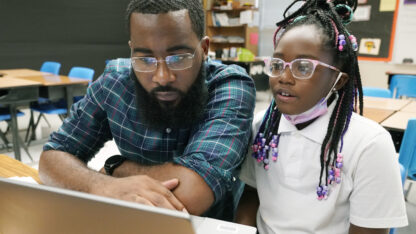This week, Republican Gov. Brian Kemp released his plan for education should he win a second term. His Democratic opponent Stacey Abrams also has plans. Both proposals would budget more money for schools, but there are some key differences.
Increased spending
The governor has centered his plan around K-12 education. If re-elected, he’ll allocate $25 million toward grants to address pandemic-related learning loss.
“Schools with students in this category may apply for these grants to leverage additional tutoring services, non-traditional staff or supplement existing learning loss services,” Kemp said when announcing his plan in Oconee County this week.
The governor said he decided to budget the money after reviewing state data showing a drop in the percentage of young students who can read on grade level.
Kemp’s plan also includes $25 million to hire more school counselors. He also says he’ll update a 2019 school safety law, which allocated $30,000 grants to schools.
“My office plans to build on the success of these grants by updating the state law to include intruder alert drills, providing voluntary anti-gang and school safety training for new and current teachers … and recommending continuing education and training updates are all school resource officers every two years,” he said.
Kemp said he’ll budget $15 million in grants for teachers’ assistants who want to become certified teachers.
“These funds will help get more teachers in the classroom and assist Georgians already passionate about our students [achieving] career success,” Kemp said.
While announcing his plan, Kemp touted legislation he signed aimed at recruiting and retaining educators and his $5,000 teacher pay raise.
Different priorities
For Abrams, the $5,000 increase isn’t enough. Her plan for K-12 schools includes raising teachers’ starting salaries to $50,000 dollars a year. It’s around $39,000 now.
Abrams has also proposed updating the state’s school funding formula, which would require legislative action.
There is some overlap between the plans in terms of topics, although the candidates’ approaches to handling those topics differ.
For example, both plans address mental health. Whereas Kemp has committed $25 million in state funds to hire school counselors, Abrams’ website says she’ll coordinate Medicaid money to allow students to access counselors at school.
Both also list school safety as a priority. To Kemp, that means beefing up K-12 security systems and offering more training. For Abrams, it means repealing Georgia’s campus carry law, which allows licensed students to bring guns on college campuses.
Some of the bigger pieces of Abrams’ plan center around higher education, including developing a need-based college aid program.
“Georgia deserves to have need-based aid,” Abrams said at a recent education roundtable. “We are one of only two states in the nation, the only one in the South that refuses to do so.”
Wyoming is the other state.
Abrams says a need-based aid program would make college attainable for more students. She says the Georgia Lottery, which funds the HOPE and state Pre-Kindergarten programs, has enough in reserves to start such a scholarship.
Long-term, Abrams plans to pay for the program by legalizing sports betting, which would also need to be approved by state lawmakers. The idea has garnered bi-partisan support in the past but bills that would have legalized the practice have stalled in the legislature. Still, Abrams is convinced she could get the votes.
“The 30,000-plus jobs that would come with casino gaming, I think are more than sufficient to convince the requisite number of legislators to vote ‘yes,’” she said.
Under Abrams’ proposal, students could use Georgia’s HOPE scholarship, which is merit-based, in conjunction with the new need-based aid program to pay for college. HOPE covers some tuition costs for students who qualify, based on their high school GPA and test scores in some cases. Abrams says the new program could complement HOPE by helping students pay for other college expenses, like room and board.
“HOPE is an important facet,” she said. “But need-based aid is about the whole cost of college.”









